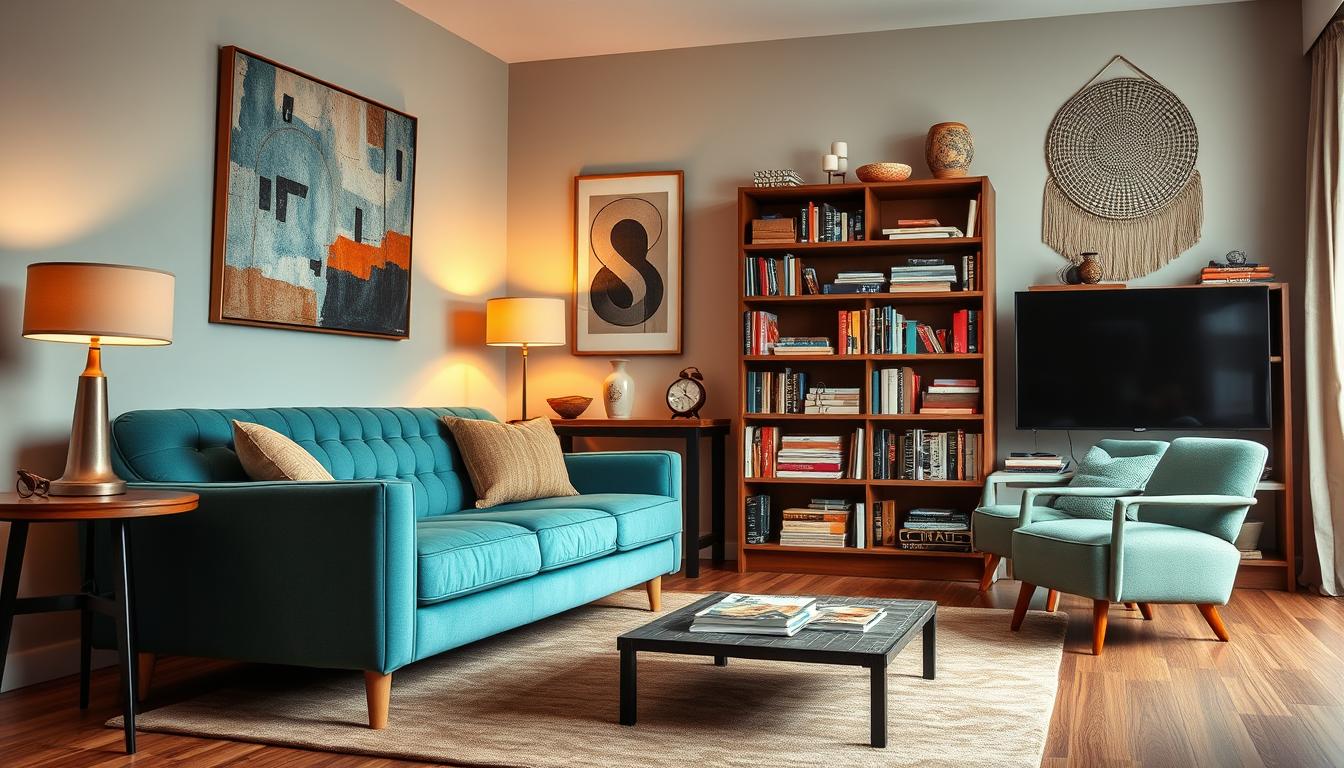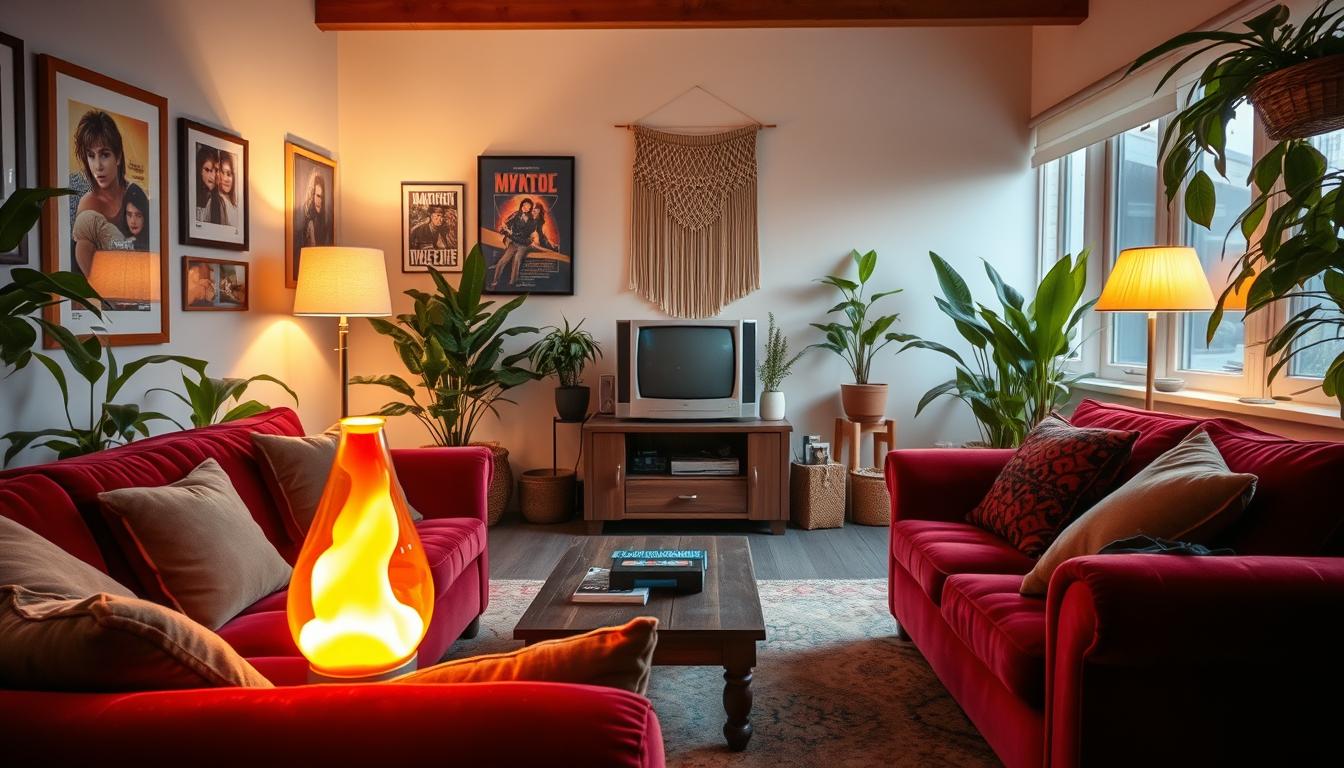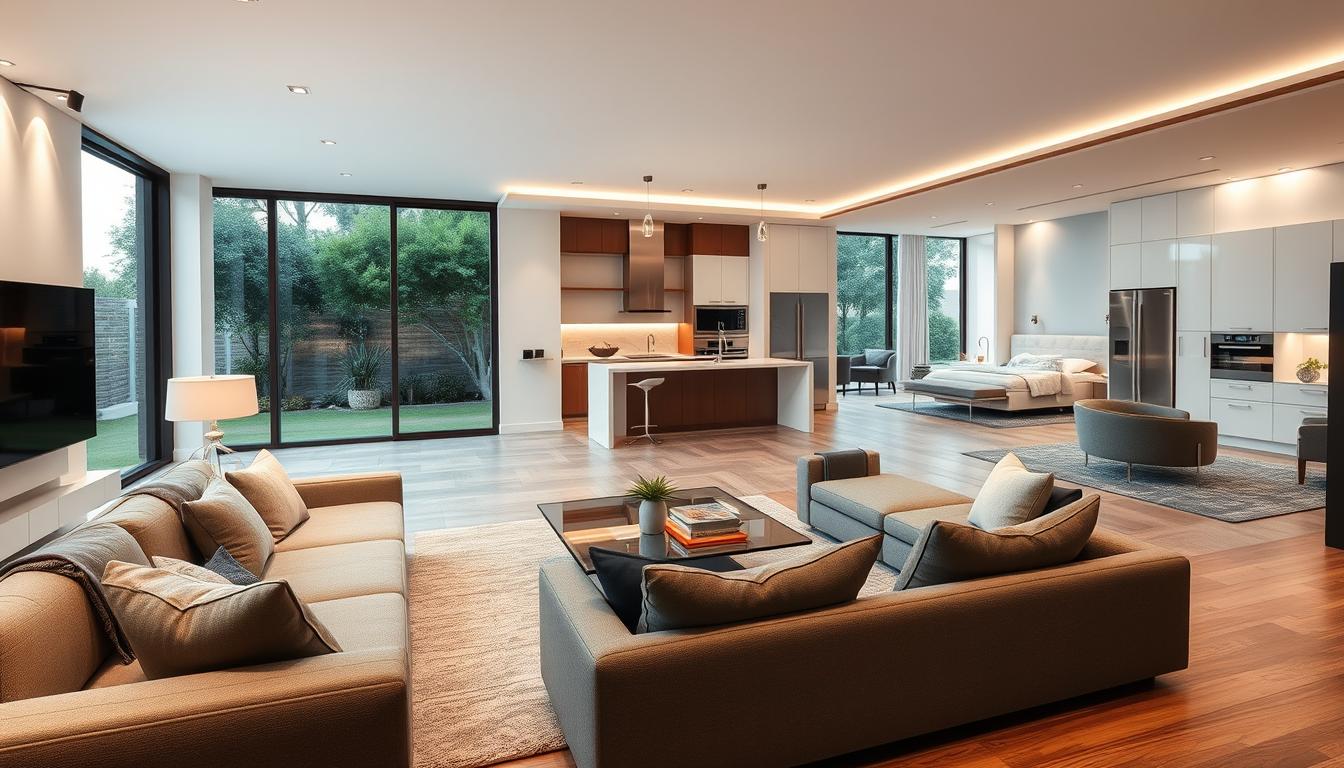The 1950s was a time of big change in retro decor. It was filled with post-war optimism that shaped designs. Did you know that back then, the idea of the “ideal home” became more real for many Americans? This led to a lot of new and exciting interior designs.
When we talk about decorating a 1950s home interior, we’ll look at what made that era special. We’ll cover furniture styles, color schemes, and give you tips on adding retro touches to your home.
Key Takeaways
- Understand the key design elements of the 1950s era.
- Learn how to incorporate retro furniture into your decor.
- Discover the iconic color palettes of the 1950s.
- Find out how to balance retro decor with modern elements.
- Get tips on sourcing authentic 1950s decor items.
Understanding the 1950s Design Aesthetic
The 1950s was a time of big change in interior design. New materials, colors, and furniture styles were introduced. These changes blended modernism with a touch of nostalgia, making homes both useful and stylish.
Key Features of 1950s Homes
1950s homes were known for their clean lines and organic shapes. They were designed to be functional and beautiful. This focus on simplicity and efficiency was key to their appeal.
- Open floor plans that encouraged family interaction
- Use of new materials like vinyl and chrome
- Incorporation of large windows to bring in natural light
Color Palettes We Love
The 1950s had a wide range of colors, from soft pastels to bold accents. These colors showed the era’s optimism and added a playful vibe to homes.
| Color | Description | Common Use |
|---|---|---|
| Pastel Pink | Soft, gentle hue | Kitchens, Bedrooms |
| Turquoise | Bright, cheerful color | Bathrooms, Accent Walls |
| Harvest Gold | Warm, earthy tone | Kitchens, Living Rooms |
Popular Materials and Textures
The 1950s brought new materials and textures into homes. Vinyl, chrome, and glass were popular for their durability and modern look.
Key Materials:
- Vinyl: Used for upholstery and flooring
- Chrome: Often used in furniture and fixtures for its sleek, modern look
- Glass: Incorporated into decorative items and furniture
Furniture Styles That Define the Era
The 1950s home interior is known for its unique furniture styles. These styles still shape design today. The era saw the rise of famous furniture brands and the spread of mid-century modern influences. It also focused on making furniture functional.
Iconic Furniture Brands
The 1950s was a key time for furniture design. Brands like Eames and Nelson became well-known. Their designs, with clean lines and a focus on function, showed the atomic age style. This style celebrated the futuristic and space-age feel of the era.
Some of the most iconic pieces from this time include:
- The Eames Lounge Chair, known for its comfort and sleek design.
- Nelson’s platform bench, which brought a sense of modernity to living rooms.
- Designs by Charles and Ray Eames that showcased innovative uses of materials like molded plywood.
Mid-Century Modern Influences
Mid-century modern design greatly influenced 1950s furniture. It focused on simplicity, function, and blending with nature. This style is known for:
| Feature | Description |
|---|---|
| Clean Lines | Furniture with minimal ornamentation, focusing on simple, geometric shapes. |
| Organic Shapes | Incorporation of natural forms and materials, bringing warmth to spaces. |
| Functionality | Pieces designed to be both beautiful and serve a practical purpose. |
Functionality Meets Style
The 1950s also emphasized combining functionality with style. Designers started using new materials and technologies. They created furniture that was both beautiful and practical.
“Good design is a lot like clear thinking made visual.” – Charles Eames
This era’s focus on blending form and function has had a lasting impact. It has influenced contemporary styles and continues to inspire designers today.
Essential Color Schemes for Our 1950s Interiors
The 1950s were a time of creativity in interior design. Color was key in defining the look of homes. It’s what gives 1950s interiors their retro charm.
Pastel Palettes
Pastel colors were a big part of 1950s design. They added a soft, whimsical touch to rooms. These colors were used in walls, kitchen appliances, and more, creating a calm atmosphere.
- Soft pink and baby blue were favorites for bedrooms and nurseries.
- Mint green and pale yellow brightened kitchens and bathrooms.
- Pastel-colored accessories, like vases, added subtle color touches.
Bold Accents
Bold colors added energy and personality to 1950s interiors. They were used in statement pieces like furniture and accessories.
Some popular bold accent colors included:
- Turquoise and coral red, paired with neutral backgrounds.
- Deep navy blue and emerald green for sophistication and glamour.
- Bright yellow and orange for a cheerful, sunny feel.
Neutrals with a Twist
Neutral colors were also big in 1950s interiors. But they were often mixed with unique textures or patterns. This created a calm, interesting environment.
Examples include:
- Using natural materials like wood and stone for warmth.
- Adding patterned textiles, like geometric-print fabrics, for interest.
- Metallic accents, like brass or copper, for glamour.
By using these color schemes, we can bring the nostalgic charm of the 1950s into our homes. We can create a unique, retro-inspired space.
Revamping Living Spaces with 1950s Charm
To give your home a 1950s vibe, we’ll look at how to update your living areas. The 1950s saw big changes in home design. New materials, colors, and furniture styles emerged.
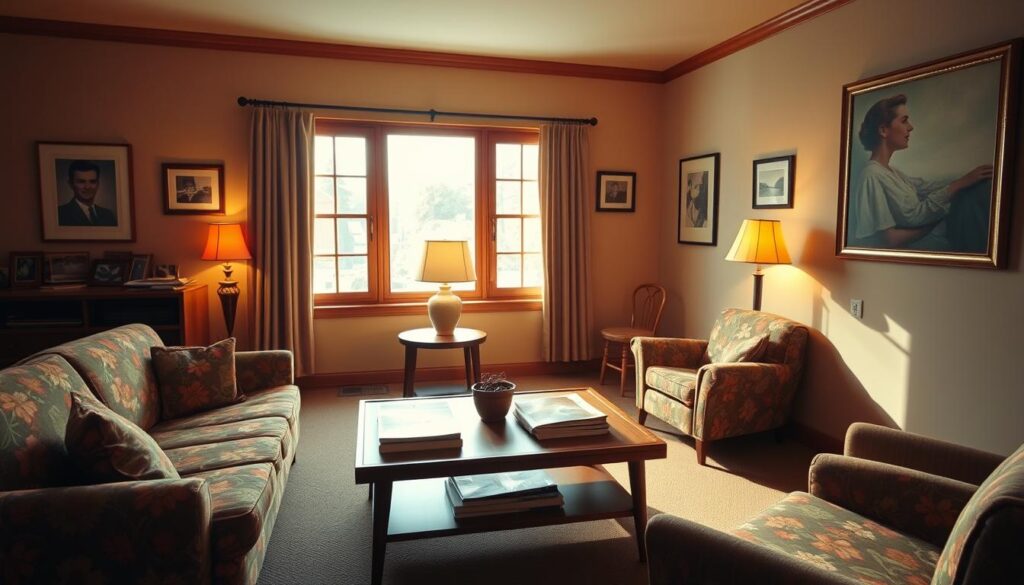
Creating a Cozy Living Room
A cozy living room is key to a 1950s home. Choose plush furniture with clean lines, like a bold-patterned sofa. Warm lighting, like sculptural table lamps, adds to the feel.
Earth tones and rich textures were big in 1950s decor. Use throw blankets, rugs, and pillows in matching colors for depth. Add vintage accessories, like retro posters or antique items, for a nostalgic touch.
Dining Room Essentials
The dining room is where elegance meets function. For a 1950s look, find a table with a sleek design, maybe in a bold color or texture. Chairs should be comfy and stylish, like vinyl or wooden ones with tapered legs.
Lighting, like a chandelier or pendant lights, can be a highlight. Use warm-toned metal accents and decorative centerpieces that show off abstract shapes and geometric patterns.
Incorporating Retro Accessories
Retro accessories are crucial for a 1950s feel. Look for vintage items like radios, clocks, or classic kitchen gadgets. Display them on shelves or mantles to add character and spark conversations.
For a softer touch, use retro-inspired patterns and motifs in your decor. This can be through textiles, wallpaper, or ceramics. It helps tie your room’s elements together and strengthens the 1950s theme.
| Element | Description | 1950s Characteristics |
|---|---|---|
| Furniture | Clean lines, organic shapes | Mid-century modern influences, bold colors |
| Color Scheme | Pastel palettes, bold accents | Neutrals with a twist, like turquoise or red |
| Accessories | Vintage items, retro patterns | Retro clocks, vintage radios, abstract shapes |
The Role of Art in Our 1950s Decor
Art was key in shaping 1950s decor. The 1950s were a time of creativity, with many artists influencing home decor.
The art of the 1950s mixed abstract expressionism and pop art. Artists like Jackson Pollock and Andy Warhol became famous. Their work showed the era’s cultural and social changes, adding a unique touch to homes.
Popular Artists from the 1950s
The 1950s saw the rise of iconic artists. Some notable ones include:
- Jackson Pollock, known for his abstract expressionist technique
- Andy Warhol, a leading figure in the pop art movement
- Mark Rothko, famous for his bold, rectangular color fields
These artists helped shape the 1950s art scene. Their work can bring retro charm to our homes.
Vintage Artwork Ideas
There are many ways to use vintage artwork in our decor. Here are a few ideas:
- Look for original prints or posters from the 1950s to hang on your walls.
- Consider reproductions of famous 1950s artworks to achieve a similar look.
- Mix vintage art with modern pieces to create a unique, eclectic style.
Using vintage artwork adds depth and character to our spaces.
Incorporating New Pieces
New pieces can also create a retro-inspired look. Here are some tips:
- Choose artwork that reflects the colors and styles of the 1950s.
- Consider commissioning a local artist to create a piece inspired by 1950s art.
- Look for modern reproductions of classic 1950s artworks.
By mixing vintage and new pieces, we can create a space that honors the 1950s.
Interior design expert notes:
“The key to incorporating 1950s art into your decor is to balance it with other design elements, such as furniture and color schemes.”
| Artistic Style | Key Features | Decorating Ideas |
|---|---|---|
| Abstract Expressionism | Emphasis on process, spontaneous creation | Use bold, abstract pieces as focal points |
| Pop Art | Bold colors, graphic prints, consumer culture references | Incorporate colorful, graphic prints into your decor |
Designing a 1950s Kitchen
The 1950s kitchen was a lively place where function and style came together. We’ll explore the key elements that make a 1950s kitchen special. This includes the appliances, layout, and decor that bring it to life.
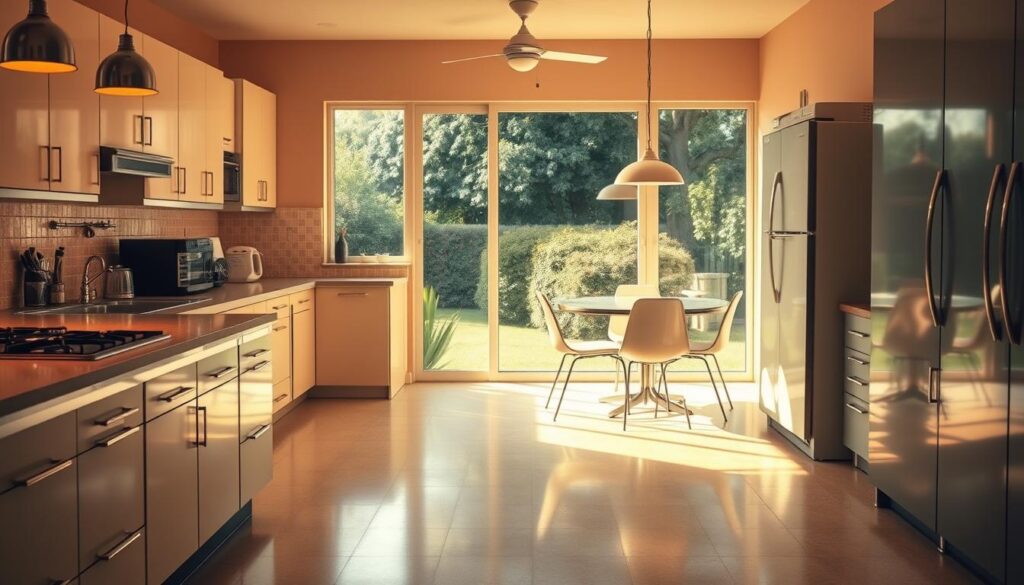
Appliances That Define the Decade
In the 1950s, iconic appliances became a hallmark of kitchen design. Brands like General Electric and Frigidaire introduced sleek, colorful refrigerators and stoves. These appliances added a splash of color to kitchens.
Today, these vintage appliances are back in style. They bring a touch of nostalgia and whimsy to modern kitchens.
Some of the most iconic appliances of the decade include:
- Pastel-colored refrigerators and stoves
- Chrome-accented dishwashers and sinks
- Retro-style toasters and blenders
| Appliance | Typical Color | Design Feature |
|---|---|---|
| Refrigerator | Pastel pink or blue | Chrome handles |
| Stove | White or black | Retro-style dials |
| Dishwasher | Chrome or stainless steel | Simple, clean design |
Layout Considerations
The layout of a 1950s kitchen focused on function and efficiency. It followed the “work triangle” concept, placing the sink, stove, and refrigerator in a triangle. This layout made moving between tasks easy, making cooking and cleaning simple.
“The kitchen is the heart of the home, and in the 1950s, it was designed to be a warm and welcoming space that fostered socializing and family bonding.”
Colorful Backsplashes and Countertops
Colorful backsplashes and countertops were key to a 1950s kitchen. Homeowners chose bold colors like red, turquoise, and yellow. These colors were used in materials like ceramic tile, Formica, and stainless steel.
To add this retro charm to your kitchen, consider using:
- Colorful ceramic tile backsplashes
- Patterned Formica countertops
- Stainless steel or chrome accents
Retro Bathroom Inspirations
In the 1950s, bathrooms were a mix of atomic age style and classic decor. Today, we can bring back that nostalgic charm. We just need to add elements popular back then.
Classic Fittings and Fixtures
Classic fittings and fixtures were key in 1950s bathrooms. Chrome-plated faucets and elegant sink designs were big, adding sophistication. We can find modern versions that still look retro.
Tile Choices and Patterns
1950s bathrooms had bold, colorful tiles. Hexagonal tiles and geometric patterns were favorites. They added interest and a lively feel. Mixing patterns and colors can give our bathrooms a nostalgic look.
Storage Solutions
Storage in 1950s bathrooms was both useful and stylish. Medicine cabinets with mirrored doors and linen closets were common. They kept things handy and looked good. We can use similar ideas in our bathrooms today.
By using these elements, we can make our bathrooms both functional and a nod to the 1950s. Whether it’s vintage fixtures, bold tiles, or smart storage, we can turn our bathrooms into retro gems.
Bringing 1950s Style to Bedrooms
A 1950s-inspired bedroom is a great throwback interior. We’ll show you how to get this retro look. We’ll look at the key elements of the era’s style.
Furniture Selections We Admire
The 1950s furniture is known for clean lines and organic shapes. It’s all about being functional. Designers like Charles and Ray Eames were pioneers in using new materials.
Think about adding a vintage dresser or a retro-style bed frame. These pieces will anchor your bedroom’s design.
Bed Linens and Accessories
Bed linens and accessories are key to 1950s style. Choose vintage-inspired patterns like florals, stripes, or geometric motifs. Add throw pillows, blankets, and a retro-style rug to finish the look.
Don’t forget nostalgic accessories like vintage lamps or antique decorative items. They add to the charm.
Lighting That Complements
Lighting is crucial for a room’s ambiance. For a 1950s-inspired bedroom, use sputnik chandeliers, globe lamps, or table lamps with a retro look. These lights not only light up the room but also decorate it.
Crafting Outdoor Spaces with a Vintage Touch
The 1950s was a time of big change for outdoor living. Patio furniture and gardens became part of the home. We’re looking to bring back that vintage charm, focusing on key elements from that era.
Patio Furniture of the 1950s
Patio furniture in the 1950s was both durable and stylish. Wicker and metal were top choices, known for their detailed designs and bright colors. Today, we can find retro-style wicker sofas and metal tables with geometric patterns. For more ideas, check out our guide on recreating 1950s home interiors.
Colorful Gardens
Gardens in the 1950s were lively, filled with colorful flowers and lush greenery. To get this look, plant bold-colored flowers like tulips, daisies, and petunias. Adding flowering shrubs and colorful garden statues can also add to the retro vibe.
Incorporating Retro Elements
To make our outdoor spaces feel like the 1950s, we need to add retro touches. Look for vintage or vintage-inspired items like retro-themed garden ornaments, old metal signs, and classic outdoor lights. These elements help create a charming outdoor area that captures the essence of the 1950s.
Final Touches for a Complete Look
To finish our 1950s-inspired home, we need to add the final touches. These touches bring the space to life. We can use vintage furnishings and mid-century modern design to create a stylish atmosphere.
Adding Vintage Flair
Adding vintage finds is a great way to add character. We can look for unique pieces in antique stores, thrift shops, or online. Items like vintage posters, retro lamps, or classic decorations are perfect.
DIY Decor Ideas
We can also get creative with DIY decor. Upcycling old furniture or making macrame wall hangings are great ideas. Using vintage patterns and materials adds a personal touch.
Personalizing Our Space
To make our home truly unique, we should add personal touches. Mixing vintage elements with our personal treasures makes the space authentic. It showcases the beauty of mid-century modern design.

